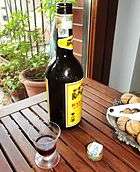Ratafia
Ratafia is a term used for two types of sweet alcoholic beverages and a flavouring essence whose taste resembles bitter almonds[1] and later to a ratafia flavoured biscuit or a biscuit to be eaten along with ratafia, and later still to a cherry variety.[2][3][4]
Ratafia from La Pobla de Segur | |
| Type | Sweet alcoholic beverage |
|---|---|
| Country of origin | Mediterranean |
| Flavour | Fruits or kernels, usually almond, or the kernels of peach, apricot or cherry |

Oxford English Dictionary earliest date of use: 1699.[2]
Liqueur
The first type of alcoholic beverage is a liqueur or cordial flavoured with fruits or kernels, usually almond, or the kernels of peach, apricot or cherry.[2] Ratafias were distinctive as the alcohol was not distilled, the flavouring ingredients being merely infused in it [5][2] Ratafia may be flavored with lemon peel and spices in various amounts (nutmeg, cinnamon, clove, mint, rosemary, anise, etc.), typically combined with sugar. Other flavorings can be used, such as vegetables and fresh herbs. The liqueur is typical of the Mediterranean areas of Spain, Italy, and north-east of France (Champagne and Burgundy). In the south-central region of Italy (specifically Molise and Abruzzo) Ratafià is made exclusively with fresh cherries and Montepulciano d'Abruzzo wines.
Fortified wine
The second type, Ratafia fortified wine, is a type of mistelle, a mixture of marc and the unfermented juice of the grape, and is the type produced in France. There are very few producers of Ratafia fortified wine. The fortified wine, one of which is made today in New Mexico by producer D.H. Lescombes, uses Moscato grapes fortified with brandy to stop the fermentation early, which keeps the residual sugar high. The resulting wine is rich and sweet.
Biscuit
"a small macaroon flavoured with almonds"
− Collins English Dictionary[6]
Ratafia Biscuits are made with ratafia essence, sweet almonds, apricot kernels, rosewater, egg white, sugar.[7][8] Originally made with sweet and bitter almonds, now apricot kernels.[7] Amaretto is a ratafia liquor, thus the ratafia biscuits.[7]
In The Compleat Housewife, Eliza Smith included a recipe for To make Ratafia Bisket,[9] with the ingredients: bitter almonds, sugar and egg white, making it a confection that is very similar to a modern macaroon.[2][10][11]
Other Uses
Ratafia essence was suggested in a BBC recipe in their 1940 publication, Food Facts For The Kitchen Front, for making mock marzipan, along with soya flour, margarine and sugar.[12]
References
Notes
- Lawson, Nigella (11 December 2012). "Flavourings for Christmas Baking". Nigella.com. Retrieved 21 May 2019.
- "Ratafia biscuit". British History Online. Retrieved 2020-02-03.
- "Ratafia biscuits". Waitrose. Waitrose & Partners. Retrieved 21 May 2019.
- "Ratafia biscuits recipes". BBC Food. British Broadcasting Corporation. Retrieved 21 May 2019.
- Froud and Turgeon (1961)
- "Ratafia biscuit definition and meaning". Collins English Dictionary. Retrieved 2020-02-03.
- "18th Century: Ratafia Biscuits from Pride and Pudding: The History of British Puddings, Savoury and Sweet by Regula Ysewijn". app.ckbk.com. Retrieved 2020-02-03.
- "Ratafia Biscuits Recipe". Food.com. Retrieved 2020-02-03.
- Smith, E. (Eliza) (2004-12-03). "The compleat housewife: or, Accomplish'd gentlewoman's companion: being a collection of several hundred of the most approved receipts, in cookery, pastry, confectionary, preserving, pickles, cakes, creams, jellies, made wines, cordials. And also bills of fare for every month in the year. : To which is added, a collection of near two hundred family receipts of medicines; viz. drinks, syrups, salves, ointments, and many other things of sovereign and approved efficacy in most distempers, pains, aches, wounds, sores, &c. never before made publick in these parts; fit either for private families, or such publick-spirited gentlewomen as would be beneficent to their poor neighbors. / By E. Smith". Retrieved 2020-02-03.
- Smith, Eliza (1739-02-03). "The Compleat Housewife: Or, Accomplish'd Gentlewoman's Companion:: Being a Collection of Upwards of Six Hundred of the Most Approved Receipts in Cookery, Pastry, Confectionary, Preserving, Pickles, Cakes, Creams, Jellies, Made Wines, Cordials. With Copper Plates Curiously Engraven for the Regular Disposition of Placing the Various Dishes and Courses. And Also Bills of Fare for Every Month in the Year. To which is Added, a Collection of Above Three Hundred Family Receipts of Medicines: Viz. Drinks, Syrups, Salves, Ointments ..." J. and J. Pemberton. Retrieved 2020-02-03 – via Google Books.
- Smith, E. (Eliza) (1773-02-03). "The compleat housewife, or, Accomplished gentlewoman's companion : being a collection of upwards of seven hundred of the most approved receipts in cookery, pastry, confectionary, potting, collaring, preserving, pickles, cakes, custards, creams, preserves, conserves, syrups, jellies, made wines, cordials, distilling, brewing : with copper plates, curiously engraven, for the regular disposition or placing of the various dishes and courses : and also, bills of fare for every month in the year : to which is added, a collection of three hundred receipts of medicines, consisting of drinks, syrups, salves, ointments, &c. which, after many years of experience, have been proved to be innocent in their application, and most salutary in their use : with directions for marketing". London : Printed for J. Buckland, J. and F. Rivington, J. Hinton, Hawes, Clarke and Collins, W. Johnston, C. Crowder, T. Longman, B. Law, T. Lowndes, S. Bladon, W. Nicoll, and C. and R. Ward. Retrieved 2020-02-03 – via Internet Archive.
- Ekins, Carolyn. "Mock Marzipan No.100". The 1940s Experiment. Retrieved 29 April 2020.
Sources

